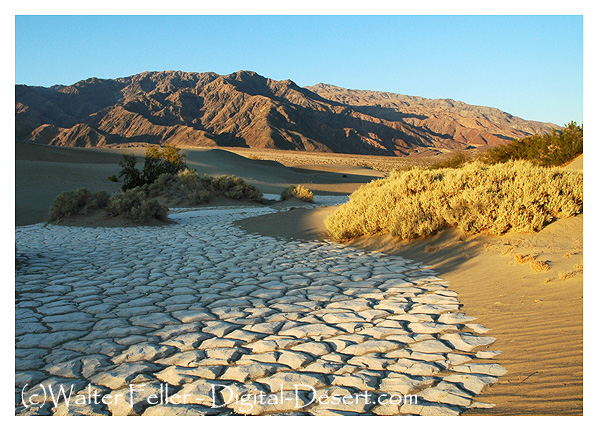Sand Accumulation
Two primary factors are necessary for the accumulation of sand into sand sheets and dunes: 1) an adequate supply of sand, and 2) winds strong enough and persistent enough to move the sand (McKee, 1979). If these two conditions are met, large quantities of sand can be transported hundreds and even thousands of miles (Fryberger and Ahlbrandt, 1979).What makes sand accumulate into piles rather than spread out evenly over an area? In general, sand will tend to accumulate any place "where a sufficient reduction of wind energy exists along the direction of sand drift in an active extensive system" (Fryberger and Ahlbrandt, 1979, p. 454). Any obstacle, such as a rock outcrop or a stand of vegetation, can force sand accumulation by lowering wind speeds and creating a "sand shadow" to the lee of the obstacle. Any small depression or gentle dip in an otherwise flat surface can fill with sand due to lower wind velocity within the depression (Cooke and Warren, 1973). Large areas of persistent wind deceleration, such as a basin or the base of a plateau, can spawn the creation of large ergs. In fact, most desert eolian sand seas do occur in basins (Fryberger and Ahlbrandt, 1979; Cooke and Warren, 1973).

Blowout, Mesquite Flats Dunes, Death Valley
Obstacles, however, are not needed for sand accumulation. According to Bagnold (1941, p.6), sand "alone of all artificial solids (has) the power of self-accumulation." This self-accumulation results from two processes: 1) the differential speed of saltating sand over sandy versus non-sandy surfaces, and 2) the drag effect of saltating sand grains on wind velocity.
As mentioned in the previous section, saltation over a coarse surface generally takes the form of repeated bouncing of individual grains. In such cases, most of the wind-imparted momentum is conserved and grains move rapidly downwind. In saltation over a sandy surface, however, sand grains impact into the surface, transferring some energy to the surface (via surface creep) and some energy to dislodging other grains into the air. This process produces a slower downwind movement of sand (Bagnold, 1941).
A second factor favoring self-accumulation of sand is "saltation drag." Friction produced by the saltating sand grains slows down wind speed near the surface. Thus, despite the smoother surface of a sandy area, "a given wind can drive sand over a hard immobile surface at a considerably greater rate than is allowed by the loose sandy surface" (Bagnold, p. 72). This negative feedback effect of saltating sand is so great, in fact, that it places a maximum limit on near-surface wind velocity. In effect, increasing wind velocity also increases saltation and saltation drag to the point where energy lost by increasing friction equals the energy gained by increasing velocity. At that point, further increases in wind velocity outside the sandy area do not produce any increase in velocity over the sand; in fact, increased saltation drag may actually reduce near-surface wind speed over the sand and result in vigorous deposition of grains. Hence, strong winds tend to favor sand accumulation in areas already sand-covered (Bagnold, 1941).
Small-scale Sand Accumulation Features
NATURAL FORMATIONS
Rock Formations
Sand Dunes
Dry Lakes
Water Sources
Craters
Arches & Bridges
Views & Vistas
Geology